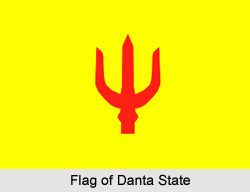 The Princely State of Danta was one of the 9 Gun Salute States of India under the rule of the British Empire in India. During the early 19th century, the region was appointed as one of the princely states of India under the indirect rule of the British administration. The taluka was scattered over a total area of 347 sq miles and comprised of a total population of 31,110 in the year 1941. The erstwhile princely state of Danta was located in the southern Rajputana region and consisted of around 360 villages, along with the capital Danta Bhawanghad. The territory was bordered by the princely state of Sirohi in the north; by the princely state of Idar in the east; by Sudasna in the south; and by the princely state of Palanpur in the west. Danta state was a under the administrative control of Western Rajputana States Agency, a part of the Rajputana Agency. The region also belonged to the Sabar Kantha Agency in Gujarat until the year 1933.
The Princely State of Danta was one of the 9 Gun Salute States of India under the rule of the British Empire in India. During the early 19th century, the region was appointed as one of the princely states of India under the indirect rule of the British administration. The taluka was scattered over a total area of 347 sq miles and comprised of a total population of 31,110 in the year 1941. The erstwhile princely state of Danta was located in the southern Rajputana region and consisted of around 360 villages, along with the capital Danta Bhawanghad. The territory was bordered by the princely state of Sirohi in the north; by the princely state of Idar in the east; by Sudasna in the south; and by the princely state of Palanpur in the west. Danta state was a under the administrative control of Western Rajputana States Agency, a part of the Rajputana Agency. The region also belonged to the Sabar Kantha Agency in Gujarat until the year 1933.
History of Princely State of Danta
The Parmar dynasty of Rajputs was the ruling family of the princely state of Danta. The family descended from the Emperor Vikramaditya of Ujjain of the Agnikula clan. The foundations of the state of Danta were laid by Jasraji in 1068 when he was expelled by the Mughal forces from Sind. Sudasna was founded as a jagir for the brother of the Maharana of the territory in the year 1782. The district of Gadhwana was granted as a jagir to Koli chiefs, for their service to the state, at various periods. The prolonged conflicts between the Parmars of Danta state and the Rathors of Idar state resulted in the dtachment of some of the remote districts of Danta.
The Princely State of Danta was honoured as one of the Salute States of India with a gun salute of 9 guns. The native ruler of the state, who held the title of Maharana, exercised full powers of administration, along with the absolute authority in civil and criminal issues. The princely state of Danta paid tributes to the princely states of Idar and Baroda. The Maharana of Danta was an original member of the Chamber of Princes in his own right.
The last native ruler or Maharana of Danta state, who was the 39th of his line, acceded the princely state to the Dominion of India, also known as Union of India on 6 November 1948 acceded the princely state to the Dominion of India, also known as Union of India. At present, Danta is a town in the district of Banas Kantha in Gujarat state, India.



















